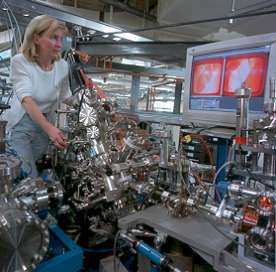| BERKELEY, CA. -- In 1905, one of the papers
that brought Albert Einstein international recognition was his explanation of the puzzling
photoelectric effect: depending on its frequency, light falling on metal
can stimulate the emission of electrons and a flow of electricity. How? Light is
quantized, Einstein proposed; the energy of the quantum (later named a photon) depends on
the frequency of the light, and a quantum of the right energy boosts an electron out of
its orbit.
The same phenomenon makes the PEEM2 at the Advanced Light Source (ALS) -- a new
photoemission electron microscope recently commissioned on beamline 7.3.1.1 -- a powerful
tool for studying materials: their structures, elemental make-up, chemical bonds, the
orientation of their molecules, and their magnetic properties.
 |
 SIMONE ANDERS OF THE ADVANCED LIGHT SOURCE USES THE
PEEM2 MICROSCOPE TO STUDY THE ORIENTATION OF MAGNETIC DOMAINS IN A STORAGE DEVICE
|
X-rays or extreme ultraviolet light produced by the ALS can be tuned to knock copious
amounts of electrons out of a sample. PEEM2 focuses the emitted electrons on a phosphor
screen, and the visible-light image produced this way is aquired by a
charge-coupled- device camera (CCD) with a resolution of 20 nanometers (billionths of a
meter) -- more than ten times better than the resolution of the best optical microscopes.
PEEM2 accepts samples up to 15 millimeters wide and can be fitted with any one of four
changeable apertures, from as wide as two millimeters to as narrow as 12 microns.
"The narrowest aperture gives the highest resolution," explains Simone Anders,
leader of the team in the ALS Experimental Systems Group, headed by Howard Padmore, which
designed the microscope, "but there’s a trade-off between resolution and
electron transmission."
In a photoemission electron microscope, the x-ray spot illuminating the sample is wider
than the microscope’s field of view, and the resolution is limited only by the
focusing system. PEEM2’s four electrostatic lenses focus the image at variable
magnification. A typical exposure time is several seconds, although the CCD can capture up
to four images a second.
A high-vacuum preparation chamber allows sample preparation right at the PEEM2
end-station. Inside the vacuum chamber, thin films and multilayer structures can be grown;
samples can be cleaned by sputtering and characterized using such standard techniques as
low-energy electron diffraction, and they can also be heated to 1500 degrees C before
being carried into the beam line on a motorized rod.
PEEM2 combines the traditional features of photoemision electron microscopy, including
the ability to determine surface topography, with such spectrographic techniques as Near
Edge X-ray Absorption Fine Structure (NEXAFS) spectroscopy, which is practical only with
synchrotron radiation.
In NEXAFS, an x-ray photon excites an electron orbiting the core of an atom or molecule
to leave its orbit and jump to a higher energy level. The step-like vertical rise in a
graph showing the absorption intensity as a function of the energy of the x-ray is called
an "edge;" for each electron orbital the position of the edge differs according
to the individual element, chemical bond, or molecular orientation. Tuning radiation to
different frequencies can thus produce spectrographic information which becomes part of
the visual image, revealing just where in the sample certain elements or certain kinds of
chemical bonds occur.
Because it uses light from a bending magnet, PEEM2 can do more. The beam leaving a
bending magnet can be masked to emit either linearly polarized light, or right or left
circularly polarized light. Linearly polarized light is useful to determine the
orientation of bonds in thin films, for example.
Magnetic regions of a sample exhibit a phenomenon known as circular dichroism, the
difference in their absorption of right and left circularly polarized light; a magnetic
contrast is visible because of the different interaction of the spin of the radiation with
magnetic domains of opposite orientation. With a beam tuned to a characteristic absorption
edge of a magnetic material such as cobalt, PEEM2 can look at the surface of a computer
disk, for example, and distinguish the orientation of its innumerable magnetic bits with
high resolution.
"PEEM2 can even distinguish the magnetic properties of individual layers in
multilayer structures," says Anders. "Magnetic multilayers may soon be used in
magnetic memories, replacing electronic memory chips for various applications."
She lists other examples of the kind of research pertinent to the future of the
electronics industry: "Because it can distinguish between chemical bonds, PEEM2 can
map areas of predominately diamond-like bonds versus areas of graphite-like bonds in thin
films of amorphous carbon, which are of potential use in flat-panel displays. And because
PEEM2 can distinguish molecular orientations, it can be used to examine the mechanisms of
polymer alignment." Aligned polymer thin films are important components of liquid
crystal displays.
"The strength of PEEM2 is that no other microscope can do all this," Anders
says. "That’s one of the reasons why the Department of Energy entered into a
CRADA" -- a Cooperative Research and Development Agreement -- "with IBM to build
and use it at the Advanced Light Source."
Anders and her coworkers, including Joachim Stöhr of IBM, Michael Scheinfein of
Arizona State University, and a team of ALS engineers led by Ron Duarte, constructed PEEM2
over a three-year period and have been its principal users, but beginning in February of
1999, half the beam-time of the microscope and its beamline will be available to qualified
outside users.
Meanwhile Anders and her colleagues are advancing further toward the high-resolution
frontier with a design for an even higher resolution instrument, the PEEM3. |


